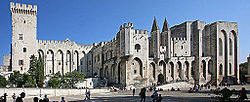A request that this article title be changed to 1370 conclave is under discussion . Please do not move this article until the discussion is closed. |
| Papal conclave December 1370 | |
|---|---|
| Dates and location | |
| 29–30 December 1370 Palais des Papes, Avignon | |
| Key officials | |
| Dean | Guy de Boulogne |
| Camerlengo | Arnaud Aubert |
| Protodeacon | Pierre Roger de Beaufort |
| Elected pope | |
| Pierre de Beaufort Name taken: Gregory XI | |
 | |
In the papal conclave held on 29 and 30 December 1370, after the death of Pope Urban V, Cardinal Pierre de Beaufort was elected pope under the name Gregory XI. He thus became seventh and the last pope of the period of Avignon Papacy.
